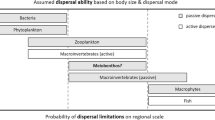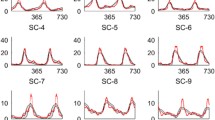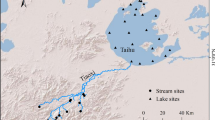Abstract
Theoretical development in the field of community ecology needs ground proofing with empirical tests. In addition, these tests need to be continuously updated. Cottenie (2005) linked observed metacommunities to theoretical models based on whether environmental and/or spatial effects in the observed metacommunity significantly explain community structure. However, a species-sorting metacommunity with high dispersal and one with limited dispersal cannot be distinguished in this manner; both produce significant environmental and spatial effects. In the present study, we demonstrate a solution to this problem using a zooplankton rock pool metacommunity in Churchill, Manitoba, sampled in August 2006. We established a hierarchy of metacommunities in the Churchill rock bluff system—a large, across-bluff metacommunity, and small, within-bluff metacommunities. Using this spatial hierarchy, it is possible to determine the zooplankton dispersal capability in the rock bluff system and hence to link the metacommunity to its corresponding model. We found the zooplankton rock bluff system to exhibit limited dispersal, meaning that spatial effects were significant at the across-bluff scale, but depending on the bluff, were significant or insignificant at the within-bluff scale. Environmental effects were significant at both scales. This study demonstrates a novel way to determine dispersal capabilities in species that are cryptic dispersers, and to successfully link observed metacommunities with theoretical models.





Similar content being viewed by others
References
Agrawal, A. A., D. D. Ackerly, F. Adler, A. E. Arnold, C. Cáceres, D. F. Doak, E. Post, P. J. Hudson, J. Maron, K. A. Mooney, M. Power, D. Schemske, J. Stachowicz, S. Strauss, M. G. Turner & E. Werner, 2007. Filling key gaps in population and community ecology. Frontiers in Ecology and the Environment 5: 145–152.
Bell, T., D. Ager, J. I. Song, J. A. Newman, I. P. Thompson, A. K. Lilley & C. J. van der Gast, 2005. Larger islands house more bacterial taxa. Science 308: 1884.
Brendonck, L. & B. J. Riddoch, 1999. Wind-borne short-range egg dispersal in anostracans (Crustacea: Branchiopoda). Biological Journal of the Linnean Society 67: 87–95.
Caceres, C. E. & D. A. Soluk, 2002. Blowing in the wind: a field test of overland dispersal and colonization by aquatic invertebrates. Oecologia 131: 402–408.
Cottenie, K., 2005. Integrating environmental and spatial processes in ecological community dynamics. Ecology Letters 8: 1175–1182.
Eitam, A., L. Blaustein, K. Van Damme, H. J. Dumont & K. Martens, 2004. Crustacean species richness in temporary pools: relationships with habitat traits. Hydrobiologia 525: 125–130.
Ellis, A. M., L. P. Lounibos & M. Holyoak, 2006. Evaluating the long-term metacommunity dynamics of tree hole mosquitoes. Ecology 87: 2582–2590.
Finlay, B. J. & K. J. Clarke, 1999. Ubiquitous dispersal of microbial species. Nature 400: 828.
Foissner, W., 2006. Biogeography and dispersal of micro-organisms: a review emphasizing protists. Acta Protozoologica 45: 111–136.
Frisch, D., E. Moreno-Ostos & A. J. Green, 2006. Species richness and distribution of copepods and cladocerans in relation to hydroperiod and other environmental variables in Doñana, south-west Spain. Hydrobiologia 556: 327–340.
Green, A. J. & J. Figuerola, 2005. Recent advances in the study of long-distance dispersal of aquatic invertebrates via birds. Diversity and Distributions 11: 149–156.
Havel, J. E. & K. A. Medley, 2006. Biological invasions across spatial scales: intercontinental, regional, and local dispersal of cladoceran zooplankton. Biological Invasions 8: 459–473.
Hebert, P. D. N. & B. J. Hann, 1986. Patterns in the composition of Arctic tundra pond microcrustacean communities. Canadian Journal of Fisheries and Aquatic Sciences 43: 1416–1425.
Hulsmans, A., K. Moreau & L. De Meester, 2007. Direct and indirect measures of dispersal in the fairy shrimp Branchipodopsis wolfi indicate a small-scale isolation-by-distance pattern. Limnology and Oceanography 52: 676–684.
Jenkins, D. G., 2006. In search of quorum effects in metacommunity structure: species co-occurrence analyses. Ecology 87: 1523–1531.
Legendre, P. & L. Legendre, 1998. Numerical Ecology. Elsevier, Amsterdam.
Leibold, M. A., M. Holyoak, N. Mouquet, P. Amarasekare, J. M. Chase, M. F. Hoopes, R. D. Holt, J. B. Shurin, R. Law, D. Tilman, M. Loreau & A. Gonzalez, 2004. The metacommunity concept: a framework for multi-scale community ecology. Ecology Letters 7: 601–613.
O’Brien, W. J., M. Barfield, N. D. Bettez, G. M. Gettel, A. E. Hershey, M. E. McDonald, M. C. Miller, H. Mooers, J. Pastor, C. Richards & J. Schuldt, 2004. Physical, chemical, and biotic effects on arctic zooplankton communities and diversity. Limnology and Oceanography 49: 1250–1261.
Papke, R. T. & D. M. Ward, 2004. The importance of physical isolation to microbial diversification. FEMS Microbiology Ecology 48: 293–303.
Peres-Neto, P. R., P. Legendre, S. Dray & D. Borcard, 2006. Variation partitioning of species data matrices: estimation and comparison of fractions. Ecology 87: 2614–2625.
R Development Core Team, 2007. R: A Language and Environment for Statistical Computing. R Foundation for Statistical Computing, Vienna, Austria.
Richter-Boix, A., G. A. Llorente & A. Montori, 2007. Structure and dynamics of an amphibian metacommunity in two regions. Journal of Animal Ecology 76: 607–618.
Romanuk, T. N. & J. Kolasa, 2002. Environmental variability alters the relationship between richness and variability of community abundances in aquatic rock pool microcosms. Ecoscience 9: 55–62.
Schneider, D. W. & T. M. Frost, 1996. Habitat duration and community structure in temporary ponds. Journal of the North American Benthological Society 15: 64–86.
Serrano, L. & K. Fahd, 2005. Zooplankton communities across a hydroperiod gradient of temporary ponds in the Donana National Park (SW Spain). Wetlands 25: 101–111.
Tavernini, S., G. Mura & G. Rossetti, 2005. Factors influencing the seasonal phenology and composition of zooplankton communities in mountain temporary pools. International Review of Hydrobiology 90: 358–375.
Therriault, T. W. & J. Kolasa, 2001. Dessication frequency reduces species diversity and predictability of community structure in coastal rock pools. Israel Journal of Zoology 47: 477–489.
Weider, L. J. & P. D. N. Hebert, 1987. Ecological and physiological differentiation among low-arctic clones of Daphnia pulex. Ecology 68: 188–198.
Whitaker, R. J., D. W. Grogan & J. W. Taylor, 2003. Geographic barriers isolate endemic populations of hyperthermophilic archaea. Science 301: 976–978.
Acknowledgements
We thank the Churchill Northern Studies Centre for their hospitality, Paul Hebert and Peter Kevan for leading the Churchill trip, Larry Weider for his ‘rock-bluffing’ guidance, Tim Bartley for his field assistance, and two anonymous reviewers for their helpful comments.
Author information
Authors and Affiliations
Corresponding author
Additional information
Handling editor: S. I. Dodson
Electronic supplementary material
Below is the link to the electronic supplementary material.
Rights and permissions
About this article
Cite this article
Ng, I.S.Y., Carr, C.M. & Cottenie, K. Hierarchical zooplankton metacommunities: distinguishing between high and limiting dispersal mechanisms. Hydrobiologia 619, 133–143 (2009). https://doi.org/10.1007/s10750-008-9605-8
Received:
Revised:
Accepted:
Published:
Issue Date:
DOI: https://doi.org/10.1007/s10750-008-9605-8




